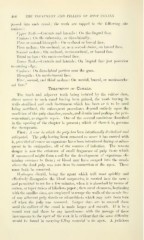Page 462 - My FlipBook
P. 462
4G0 THE TREATMENT AND FILLING OF ROOT CANALS.
passed into each canal ; the teeth are tapped in the following sit-
uations :
Upper Teeth.—Centrals and laterals : On the lingual face.
Canines On the tuberosity, or disto-labially.
:
First or second bicuspids : On occlusal or buccal face.
First molars On occlusal, or, as a second choice, on buccal face.
:
Second molars On occlusal, mesio-occlusal, or buccal face.
:
Third molars On mesio-occlusal face.
:
Loirer Teeth.—Centrals and laterals : On lingual face just posterior
to cutting edge.
Canines On disto-labial portion near the gum.
:
Bicuspids : On mosio-buccal face.
First, second, and third molars On mesial, buccal, or mesio-occlu-
:
sal face."
Treatment of Canals.
The tooth and adjacent teeth being isolated by the rubber dam,
direct access to each canal having been gained, the tooth having its
walls sterilized and each instrument which has been or is to be used
being sterilized, the subsequent procedures depend entirely upon the
condition of the pulp chamber, canals, and dentin (and perhaps the peri-
cementum), as regards sepsis. One of the several conditions described
in the opening of the chapter is present ; which of these it is, governs
the therapeusis.
First A case in which the pulp has been intentionally devitalized and
:
extirpated. The pulp having been removed en masse it has carried with
it, provided of course no organisms have been introduced during or subse-
quent to its extirpation, all of the sources of infection. The remote
danger is now the existence of small fragments of pulp tissue which
if unremoved might form a soil for the development of organisms ob-
taining entrance to them ; or blood may have escaped into the canals
where the dead pulp was torn from its connection at the apex. These
must both be removed.
Hydrogen dioxid, being the agent which will most quickly and
effectively disorganize the blood corpuscles, is carried into the canals
and permitted to act for a few minutes, when it is absorbed by means of
cotton, or taper twists of bibulous paper ; then canal cleansers, beginning
with the smaller sizes, are employed to scrape the walls of the canals free
of anv adherent pulp shreds or odontoblasts which may have been torn
oif when the pulp was removed. Larger sizes are to succeed these
until the caliber of the canal is made larger and smooth. If it be a
round root and there be any interference with the passage of these
instruments to the apex of the root, it is evident that the same difficulty
would be found in carrying filling material to its apex. A judicious


